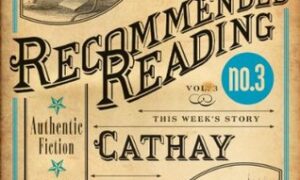 The World Before Us by Aislinn Hunter
The World Before Us by Aislinn Hunter
My rating: 3/5 cats



‘Things break, Jane, you ought to know that by now.’
remember the thing that was so frustrating about In the Woods?? the thing that made some people throw the book against the wall?? the thing that nearly made me give up on ms. french for good?? well, this book does it too. and unfortunately, while tana french wrote really crisp characters and tight scenes in her novel, which mitigated the frustrating thing somewhat, this one is frequently murky, particularly at the beginning before the threads start to come together, which makes that thing stand out more starkly at the end of the 400-plus pages.
it’s not a bad book, but it’s a little ambitious, with too little resolution. there are hints and half-answers, but my expectations for closure were largely unmet. this scene, of the protagonist’s childhood trip to see the cave paintings at font-de-gaume, resonated with me at the book’s end, because it summarized my experience perfectly:
What struck Jane about the caves was how difficult it was to see anything at all on the walls until the marks were pointed out. The lighting was dim to preserve the paintings and her eyes were slow to adjust. At a short railing, Marc stopped the group and gestured overhead. ‘I will give you a moment,’ he said. ‘See what you see.’ Jane scanned the convex limestone above her, the layers of rock yellow at her height but a brighter eggshell white above. There was a pool of brown to her right, but no shape she could distinguish clearly. Marc lifted a laser pointer to the brown stain and he used its red beam to trace the head, hump and chine of a bison. ‘Look here.’ He moved the pointer a foot to the right. ‘And here.’
…Marc stood back and let everyone take turns standing underneath the two bison. When Lewis, the last of the group, went up, Marc asked him, ‘How many do you see?’ and Lewis glanced up the corbelled vault of the cave and answered. ‘Two? Maybe three?’
‘Come close, everyone.’ Marc ushered the group together. ‘Look again,’ he said, ‘regardez.’ And he passed one of the floor lights over the upper reaches of the chamber to where a dozen bison grazed along a horizontal plane. ‘You were surrounded,’ he said cheerfully, ‘this whole time.’
or – more concisely – this sentence:
There are truths and there are the stories one wants to hear…
i wanted the story and the truth – i wanted this novel’s wall to be floodlit so i could see everything i felt entitled to by that unspoken chekhovian agreement a writer makes with their readers.
all done griping now! here’s the plot-stuff you have been waiting for:
at the outset, we are introduced to jane – a 34-year-old woman who is still haunted by the disappearance (in the WOODS) of lily, a five-year-old girl she was babysitting when she was fifteen. jane works for the chester museum, about to close its doors forever due to a lack of funding, which will in its last days be hosting an awards ceremony featuring a lecture by william eliot, who happens to be the father of the missing girl and also jane’s first crush. amidst all the half-packed boxes of exhibits on their way to new homes and her apprehension about meeting william again, jane is plagued both by her memories of that day and her growing obsession with the 1877 case of n- a woman who set out one day from the whitmore hospital for convalescent lunatics and went missing in the exact same place as lily. william’s research into victorian plant hunters and jane’s findings from the whitmore incident overlap in places, spurring her on even further in her quest to get to the truth of n’s disappearance. but despite this coincidence of scholarly overlap and parallel research paths, this is not a collaborative effort – jane’s investigation remains a solitary one. jane’s therapist tells her at one point:
‘Grief is different for everyone.’ Later he amended the statement: ‘Actually, what you have is not grief, it’s more like sorrow. You’re sorry that this happened to Lily, and sorry that it happened to you. Grief can be shared,’ he said gently. ‘What you have in common with Mr. Eliot is more like guilt. And that is always individual.’
and while it is individual, she is not exactly alone.
throughout the book, unbeknownst to jane, she is surrounded by a number of ghosties – spirits without names who follow her around, seeing what she dreams, reading over her shoulder – knowing they are connected to her and to her research but not knowing how, trying to remember who they were through the past she uncovers. the novel follows the spirits, jane’s travels, the past events at the madhouse and the nearby house, and jane’s own memories. the ghosties are referred to by their attributes, “the one who doesn’t speak,” “the theologian,” “the poet,” etc, and eventually will be revealed for who they were and where they fit into the story, but too many of them are inconsequential bit players, and combined with all the other character-heavy storylines, there are just too many people and too many of them are just hanging about, weighing down an already crowded narrative.
but there are definitely some high points: the sweetness of an unexpected relationship, the sourness of the reader learning what jane’s former boyfriend was thinking while they were having sex, the memory of her crush on william, the “invisible cities,” the poet’s cut-off recitation in the madhouse – there are a lot of lovely and memorable scenes. i just wish there was more resolution, and a less meandering narrative overall.
but fluttering!







